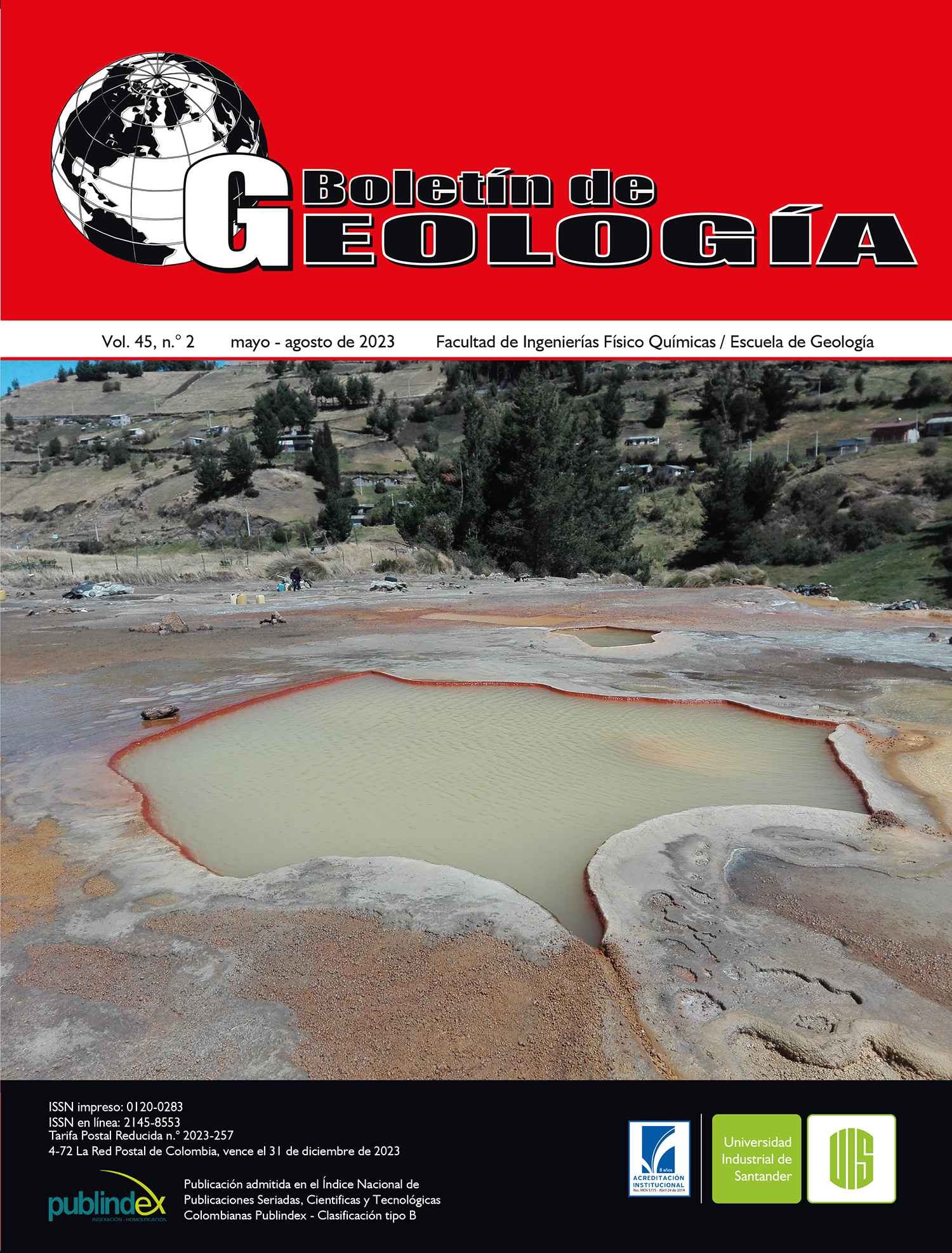Published 2023-06-15
Keywords
- Lithium,
- Brines,
- Hydrogeochemistry,
- Salts,
- Guaranda
How to Cite
Copyright (c) 2023 Boletín de Geología

This work is licensed under a Creative Commons Attribution 4.0 International License.
Altmetrics
Abstract
Lithium is considered a critical metal for its technological use. It was proposed to carry out the geochemical prospecting study in favorable environments to host possible lithium mineralization, in specific sectors of Ecuador. This would be important, as no anomalies of economic interest have been discovered to date. The content of Li in solid samples and hydrothermal waters in brines in the Guaranda sector, Bolívar province, was evaluated. Likewise, a mineralogical analysis of the solid samples and a multivariate statistical analysis of the data was carried out. The values of sub-anomalies of Li (median 222.46 mgL-1 in brines and Li in solids from Guaranda (median 201.5 ppm), may be comparable to exploitable Li deposits worldwide, which is interesting for its possible economic use. Based on the multivariate statistical analysis, chemical and mineralogical results, Li is associated with Be, and Na mainly in the solids analyzed, this is evidenced by the detection of aponite and fluoroferroleakeite. The chemical composition of the sampled waters could be the result of several processes that include: the dissolution of minerals by water-rock interaction, hydrothermal fluids related to active volcanism and/or recharge by meteoric waters.
Downloads
References
- Andreu, J.M.; Calaforra, J.M.; Cañaveras, J.C.; Cuezva, S.; Durán, J.J.; Garay, P.; García del Cura, M.A.; García-Cortés, A.; Gázquez, F.; Ordóñez, S.; Sánchez-Moral, S. (2016). Karst: un concepto muy diverso. Enseñanza de las Ciencias de la Tierra, 24(1), 6-20.
- BGS-CODIGEM. (1997). Mapa geológico de la Cordillera Occidental del Ecuador entre 1°-2º S. Dirección Nacional de Geología, Quito, Ecuador, escala 1:200000.
- Changes, A.; Swiatowska, J. (2015). Lithium Process Chemistry: Resources, Extraction, Batteries, and Recycling. Elsevier.
- Davis, J.R.; Friedman, I.; Gleason, J.D. (1986). Origin of the lithium-rich brine, Clayton Valley, Nevada. US Geological Survey Bulletin, 1622, 131-138.
- Dill, H. (2010). The “chessboard” classification scheme of mineral deposits: Mineralogy and geology from aluminum to zirconium. Earth-Science Reviews, 100(1-4), 1-420. https://doi.org/10.1016/j.earscirev.2009.10.011
- Garrett, D.E. (2004). Handbook of Lithium and Natural Calcium Chloride: Their Deposits, Processing, Uses and Properties. Elsevier Academic Press.
- Gonzaga, M.; Eguez, A.; Villares, F.; Cerón, G. (2017). Evaluación geoestadística del potencial de litio en la Cordillera Occidental del Ecuador. VIII. Jornadas Ciencias de la Tierra, Quito, Ecuador.
- Hardie, L.; Eugster, H. (1970). The evolution of closed-basin brines. Mineralogical Society of America Special Publication, 3, 273-290.
- Howarth, R.J. (1983). Statistics and Data Analysis in Geochemical Prospecting. Handbook of Geochemical Exploration, Vol. 2. Elsevier.
- Hawthorne, F.; Oberti, R.; Canillo, E.; Ottolini, L.; Roelofsen, J.N.; Martin, R.F. (2001). Li-bearing arfvedsonitic amphiboles from the Strange Lake peralkaline granite, Quebec. The Canadian Mineralogist, 39(4), 1161-1170. https://doi.org/10.2113/gscanmin.39.4.1161
- Inguaggiato, S.; Hidalgo, S.; Beate, B.; Bourquin, J. (2010). Geochemical and isotopic characterization of volcanic and geothermal fluids discharged from the Ecuadorian volcanic arc. Geofluids, 10(4), 525-541. https://doi.org/10.1111/j.1468-8123.2010.00315.x
- Li, Y.H. (1982). A brief discussion on the mean oceanic residence time of elements. Geochimica et Cosmochimica Acta, 46(12), 2671-2675. https://doi.org/10.1016/0016-7037(82)90386-6
- López-Steinmetz, R.L.; Salvi, S.; Sarchi, C.; Santamans, C.; López-Steinmetz, L.C. (2020). Lithium and Brine Geochemistry in the Salars of the Southern Puna, Andean Plateau of Argentina. Economic Geology, 115(5), 1079-1096. https://doi.org/10.5382/econgeo.4754
- Misra, K. (2012). Introduction to Geochemistry Principles and Applications. Wiley-Blackwell.
- Munk, L.; Hynek, S.; Bradley, D.; Boutt, D.; Labay, K.; Jochens, H. (2016). Lithium Brines: A Global Perspective. Reviews in Economic Geology, 18, 339-365. https://doi.org/10.5382/Rev.18.14
- Ozol, A. (1978). Plate tectonics and the process of volconogenic-sedimentary formation of boron. International Geology Review, 20(6), 692-698. https://doi.org/10.1080/00206817809471439
- Pohl, W. (2011). Economic Geology Principles and Practice Metals, Minerals, Coal and Hydrocarbons – Introduction to Formation and Sustainable Exploitation of Mineral Deposits. John Wiley & Sons Ltd. https://doi.org/10.1002/9781444394870
- Railsback, L. (2003). An earth scientist’s periodic table of the elements and their ions. Geology, 31(9), 737-740. https://doi.org/10.1130/G19542.1
- Schijf, J. (2007). Alkali elements (Na, K, Rb) and alkaline earth elements (Mg, Ca, Sr, Ba) in the anoxic brine of Orca Basin, northern Gulf of Mexico. Chemical Geology, 243(3-4), 255-274. https://doi.org/10.1016/j.chemgeo.2007.06.011
- USGS (2022). Mineral commodity summaries 2022. U.S. Geological Survey.
- Warren, J. (2014). Geochemistry of Evaporite Ores in an Earth-Scale Climatic and Tectonic Framework. In: K. Turekina, H. Holland (ed.). Treatise on Geochemistry (pp. 569-593). 2nd Edition. Vol. 13. Elsevier. https://doi.org/10.1016/B978-0-08-095975-7.01125-6
- Webmineral. (2022). Hectorite. https://www.webmineral.com/data/Hectorite.shtml

